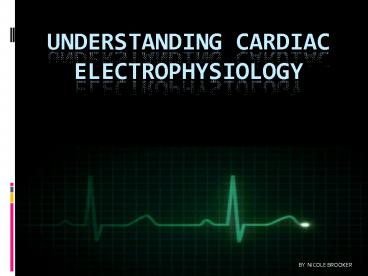Understanding Cardiac Electrophysiology - PowerPoint PPT Presentation
1 / 19
Title:
Understanding Cardiac Electrophysiology
Description:
Basic ECG Waveform The heart s electrical activity is represented by an ECG tracing by three ... BASIC ECG WAVEFORM Between the waveforms are the following ... – PowerPoint PPT presentation
Number of Views:600
Avg rating:3.0/5.0
Title: Understanding Cardiac Electrophysiology
1
Understanding Cardiac Electrophysiology
- BY NICOLE BROOKER
2
TABLE OF CONTENTS
- Electrical conduction system
- Electrical conduction pathway
- Conduction components
- The sinoatrial node (SA)
- Bachmanns bundle
- Internodal tracts
- Atrioventricular node (AV)
- Right and Left Bundle branches
- Perkinje fibers
- Ventricles
- Basic electrocardiograph (EKG) waveform
- P wave
- PR interval
- QRS complex
- ST segment
- T wave
- QT interval
3
Electrical Conduction System of the Heart
- The heart is supplied with an electrical
conduction system that generates and conducts
electrical impulses along specialized pathways - Contraction is sequence specific so the atria
contracts before the ventricle and the ventricle
contracts from apex to base for efficient
ejection of blood.
4
ELECTRICAL CONDUCTION PATHWAY
5
CONDUCTION COMPONENTS
- Sinoatrial (SA) node
- Interatrial tract (Bachmanns bundle)
- Internodal tracts, the atrioventricular (AV) node
- Bundle of His
- Right and left bundle branches
- Purkinje fibers.
6
THE SINOATRIAL NODE (SA)
- The SA node, located in the upper right atrium,
is the primary pacemaker of the heart (60 to 100
beats). - If the SA node fails to generate impulses or if
those impulses are blocked, pacemaker cells in
other sites can assume control, but at a slower
rate.
7
BACHMANNS BUNDLEINTERNODAL TRACTS
- Bachmanns bundle conducts impulses to the left
atrium, while the internodal tracts conduct
impulses to the AV node, located in the lower R
atrium near the interatrial septum.
8
ATRIOVENTRICULAR NODE
- Primary function-slow conduction of electrical
impulses coming from the atria, allowing time for
the atria to contract and empty their contents
into the ventricles. - It can functions as a backup pacemaker (40 to 60
beats). When the atrial rate is rapid, the AV
node blocks some of the impulses being conducted
to the ventricles, protecting them from
dangerously fast rates.
9
RT AND LT BUNDLE BRANCHES
- From the AV node, the electrical impulse moves
rapidly through the bundle of His and to the R
bundle branch (R ventricle) and L bundle branch (
L ventricle).
10
PURKINJE FIBERS
- The impulse then enters the Purkinje system where
Purkinje fibers conduct the impulse to myocardial
cells of the ventricle, causing ventricular
depolarization and contraction.
11
THE VENTRICLES
- The ventricles also have pacemaker cells (30 to
40 beats) that take over if impulses are not
being transmitted by the SA or AV nodes. - Repolarization follows.
12
Basic ECG Waveform
- The hearts electrical activity is represented by
an ECG tracing by three basic waveforms the P
wave, the QRS complex, and the T wave.
13
BASIC ECG WAVEFORM
- Between the waveforms are the following segments
and intervals the PR interval, the ST segment,
and the QT interval. A U wave is sometimes
present.
14
THE P WAVE
- P wave - atrial depolarization, or the spread of
the impulse from the SA node throughout the
atria.
15
THE PR INTERVAL
- PR interval - the time required for the impulse
to leave the SA node, travel through the atria,
AV node, bundle of His, bundle branches, and
Purkinje fibers.
16
THE QRS COMPLEX
- QRS Complex-represents ventricular depolarization
and is represented by three waves Q, R and S.
17
THE T WAVE
- T wave - the latter phase of ventricular
repolarization, and the vulnerable period of
repolarization (R on T phenomenon).
18
THE ST SEGMENT
- ST segment - represents the end of ventricular
depolarization and the beginning of ventricular
repolarization.
19
THE QT INTERVAL
- QT interval - the time between the onset of
ventricular depolarization and the end of
ventricular repolarization - Includes the QRS complex, ST segment, and T wave























![[PDF] DOWNLOAD EKG/ECG Interpretation Made Simple: A Practic PowerPoint PPT Presentation](https://s3.amazonaws.com/images.powershow.com/10084407.th0.jpg?_=20240724031)







